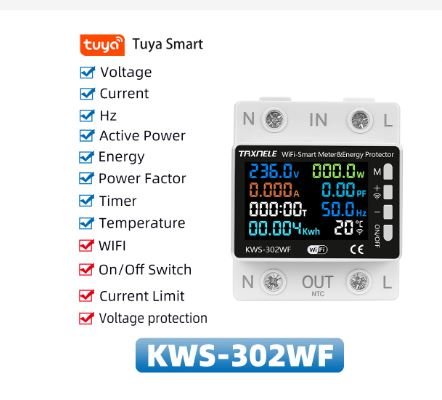Introduction to Digital Clamp Meters
A digital clamp meter is an essential tool in the field of electrical testing, offering precise measurements of electrical current without the need to directly contact a conductor. These devices have become indispensable for electricians, engineers, and technicians, providing a safer and more efficient means of monitoring electrical parameters. Traditional clamp meters, which have been in use for decades, initially relied on analog mechanisms to gauge current flow. However, the advent of digital technology has revolutionized these instruments, enhancing their accuracy, functionality, and user-friendliness.
Digital clamp meters operate by utilizing a pair of jaws that open to encircle a conductor. This design allows them to measure the magnetic field produced by the current flow, thereby determining the current without physical contact. This non-intrusive method significantly reduces the risk of electric shock, making digital clamp meters safer for professionals working in high-voltage environments. Furthermore, these meters are equipped with digital displays, offering clear and precise readings that are easier to interpret compared to their analog counterparts.
One of the standout features of modern digital clamp meters is their versatility. Beyond measuring current, they are capable of assessing voltage, resistance, continuity, and even temperature in some models. This multi-functionality makes them a valuable asset in various diagnostic and troubleshooting tasks. Additionally, digital clamp meters often incorporate advanced features such as True RMS (Root Mean Square) measurement, which ensures accurate readings even in the presence of distorted waveforms commonly found in modern electrical systems.
The evolution from traditional to digital clamp meters has brought about significant advancements in electrical testing. Digital clamp meters offer enhanced precision, user-friendly interfaces, and increased safety measures. These instruments are not only more reliable but also provide comprehensive data logging capabilities, which are crucial for detailed analysis and reporting. As technology continues to advance, the integration of wireless technology into digital clamp meters is poised to further transform the landscape of electrical testing, offering unprecedented convenience and efficiency.
Wireless Technology in Modern Clamp Meters
In the evolving landscape of electrical testing, wireless technology has emerged as a transformative feature in modern digital clamp meters. The integration of wireless connectivity into these devices offers multifaceted advantages, enhancing both their functionality and user experience. Wireless technology in clamp meters facilitates remote monitoring, allowing technicians to access real-time data from a safe distance. This capability is particularly crucial in high-voltage environments where direct contact poses significant risks. By reducing the need for physical proximity, wireless-enabled clamp meters contribute substantially to safety protocols.
Additionally, wireless connectivity supports advanced data logging and transfer functionalities. Technicians can seamlessly capture, store, and share measurement data using associated mobile applications or software platforms. This feature not only streamlines the documentation process but also enables detailed analysis and reporting. For instance, using a wireless clamp meter, an engineer can log electrical parameters over an extended period and subsequently review the data to identify trends or anomalies. Such insights are invaluable for preventive maintenance and troubleshooting, ultimately enhancing the reliability of electrical systems.
The ease of use brought about by wireless technology cannot be overstated. Modern clamp meters with Bluetooth or Wi-Fi capabilities ensure that data can be viewed and analyzed on smartphones, tablets, or computers. This flexibility allows for a more ergonomic workflow, as users are no longer tethered to the meter’s display. In practice, this means that a technician can attach the clamp meter to a conductor and then monitor the readings from a convenient location, thereby minimizing physical strain and increasing productivity.
Examples of wireless features enhancing efficiency include the ability to set up alerts for specific electrical thresholds, which can notify users immediately if a parameter exceeds a predefined limit. This proactive approach enables swift corrective actions, mitigating potential hazards or downtimes. Furthermore, the integration of wireless technology in clamp meters fosters collaboration, as multiple team members can access the same data simultaneously, facilitating coordinated efforts in complex troubleshooting scenarios.
Digital clamp meters have evolved significantly from their traditional counterparts, integrating smart multimeter capabilities that enhance their functionality and accuracy. One of the standout features of modern digital clamp meters is automatic ranging. This function allows the device to automatically select the appropriate measurement range, eliminating the need for manual adjustments. This not only simplifies the process for the user but also ensures that measurements are taken within the optimal range, thereby increasing accuracy and reliability.
Another notable capability is smart detection, which significantly enhances the user experience. Smart detection enables the digital clamp meter to automatically identify the type of measurement being taken, whether it’s voltage, current, or resistance. This feature is particularly useful in complex electrical systems, where multiple types of measurements are often required. By automatically detecting the measurement type, the digital clamp meter streamlines the testing process, reducing the likelihood of user error and ensuring more accurate results.
Enhanced measurement accuracy is a crucial benefit of these advanced features. Modern digital clamp meters utilize high-precision sensors and advanced algorithms to provide more accurate readings than traditional models. This is particularly important in applications where precision is critical, such as in industrial settings or intricate electrical installations. The enhanced accuracy of these devices makes them indispensable tools for electricians, engineers, and technicians who rely on precise data for troubleshooting and maintenance.
The versatility of digital clamp meters with smart multimeter capabilities is another significant advantage. These devices are designed to handle a wide range of electrical testing applications, from basic household wiring to complex industrial systems. Their ability to automatically range, smartly detect measurement types, and provide enhanced accuracy makes them suitable for various tasks, including diagnosing electrical issues, verifying installations, and performing routine maintenance. As a result, digital clamp meters with smart multimeter capabilities have become essential tools in the toolkit of modern electrical professionals.
Understanding True RMS Measurement
True RMS (Root Mean Square) measurement is a critical concept in the realm of electrical testing, particularly when dealing with alternating current (AC) signals. Unlike average-responding meters, True RMS meters provide a more precise reading of the effective value of varying waveforms, which is essential for accurate diagnostics and safety in electrical systems. The distinction between True RMS and average-responding meters lies in their ability to measure complex waveforms and non-linear loads effectively.
True RMS meters calculate the square root of the mean of the squares of all instantaneous values over a cycle. This method ensures that the measurement reflects the true energy content of the waveform, regardless of its shape. For instance, in environments where non-sinusoidal waveforms are common—such as those produced by variable frequency drives, electronic ballasts, or switching power supplies—True RMS measurement becomes indispensable. These devices often generate harmonic distortions and irregular waveforms that average-responding meters cannot accurately measure.
On the other hand, average-responding meters are designed to measure pure sinusoidal waveforms. They work by taking the average of the absolute value of the waveform and then applying a correction factor to approximate the RMS value. While this method can be sufficient for simple, linear AC signals, it falls short in providing accurate readings for complex waveforms. This limitation can lead to significant errors in readings, potentially causing inefficiencies or even dangerous conditions in electrical systems.
The superiority of True RMS meters in handling non-linear loads and distorted waveforms cannot be overstated. For professionals in electrical testing, the accuracy and reliability of True RMS measurements ensure that they can diagnose and troubleshoot electrical systems with confidence. As the complexity of electrical and electronic devices continues to increase, the demand for precise measurement tools like True RMS meters becomes more pronounced. Adoption of these advanced tools not only improves the accuracy of readings but also enhances overall safety and efficiency in electrical testing and maintenance.
Auto Range Functionality
The auto range functionality in digital clamp meters represents a significant advancement in electrical testing technology. This feature simplifies the measurement process by automatically selecting the appropriate range for the parameter being measured. Unlike manual range selection, where the user must determine the correct range before taking a measurement, auto range functionality allows the meter to adjust itself based on the detected signal. This automation not only enhances user convenience but also substantially reduces the likelihood of user error.
When utilizing a digital clamp meter with auto range functionality, the user is not required to have in-depth knowledge of the expected measurement range. This capability is particularly beneficial when dealing with unknown or fluctuating values, as the meter can seamlessly adapt to the changing conditions. By automatically selecting the correct range, the device ensures that measurements are both accurate and reliable, thereby increasing the overall efficiency of the measurement process.
Moreover, the auto range functionality minimizes the risk of overloading the meter, which can occur if an incorrect range is manually selected. This protective feature preserves the integrity of the meter and extends its operational lifespan. Additionally, it allows professionals to focus more on their primary tasks rather than being preoccupied with the technicalities of range selection.
Incorporating wireless technology into digital clamp meters further amplifies the benefits of auto range functionality. Wireless communication enables real-time data transfer and remote monitoring, providing users with the ability to analyze measurements without physically interacting with the meter. This integration enhances safety, especially in high-voltage environments, and contributes to a more streamlined workflow.
Overall, the auto range functionality in digital clamp meters exemplifies how modern technological advancements are making electrical testing more accessible, accurate, and efficient. By reducing user intervention and error, this feature significantly improves the reliability of measurements, making digital clamp meters an indispensable tool in the field of electrical testing.
Capacitor Testing and Measurement
Capacitors are fundamental components in electrical circuits, playing crucial roles in energy storage, filtering, and signal processing. Ensuring their optimal functionality is vital for maintaining the efficiency and reliability of electrical systems. The advancement of digital clamp meters with integrated capacitor testing capabilities represents a significant leap in the field of electrical testing.
Digital clamp meters equipped with capacitance measurement functions streamline the process of capacitor testing. These devices can measure the capacitance value directly, which simplifies the traditionally complex and time-consuming testing methods. The digital clamp meter applies a small AC voltage to the capacitor, measures the resulting current, and calculates the capacitance based on the known frequency of the applied voltage. This method is not only accurate but also efficient, allowing for quick assessments of capacitor health.
The importance of capacitor testing cannot be overstated. Faulty capacitors can lead to a range of issues, from decreased performance to complete circuit failure. By integrating capacitor testing into digital clamp meters, technicians can perform comprehensive diagnostics with a single tool. This integration saves time and reduces the need for multiple instruments, making it an invaluable feature for both fieldwork and laboratory settings.
Moreover, the digital clamp meter’s ability to test capacitors enhances safety and convenience. Traditional methods often required the capacitor to be removed from the circuit for testing, posing risks of electric shock and circuit damage. The modern digital clamp meter, however, can test capacitors in situ, minimizing these risks while providing accurate measurements. This non-invasive testing is particularly beneficial in high-voltage environments where safety is paramount.
Incorporating capacitor testing into digital clamp meters with wireless technology further amplifies their utility. Wireless connectivity allows for remote monitoring and data logging, enabling more detailed analysis and easier record-keeping. This feature is especially advantageous in complex electrical systems where continuous monitoring is necessary to preemptively address potential issues.
In summary, the integration of capacitor testing capabilities in digital clamp meters represents a significant advancement in electrical testing technology. These multifunctional devices enhance efficiency, safety, and convenience, making them indispensable tools for modern electrical diagnostics.
Product introduction:
ZT-5BQ is an ultra-portable Bluetooth smart clamp meter
, which can intelligently identify voltage, resistance and continuity measurements. In the basic measurement we do not need to change.
It is the first clamp meter that is fully compatible with DENIU 1.0.


Product advantages:
1. Bluetooth connection: The mobile phone can directly control the multimeter.
2. Additional measurement data applications: data logging, data graphics, data sharing, data storage and export, threshold alarm.
3.Multi-meter interoperability: The App can connect four Bluetooth multimeters and check the measurement data of four multimeters simultaneously in real time.
4. Intelligent Calculation Function: Use multimeter data to quickly calculate mathematical formulas such as energy.
5.Remote Assistance: Real-time remote screen synchronization, easy remote center communication and remote real-time monitoring.
6. Find the main multimeter user communication platform.
Five main categories: home appliance repair, electrician knowledge, circuit synthesis, Q&A and fans discussions.
Order Announcement
Here are the app download websites: Favorite friends can download it in advance. Thank you!
https://multimeter.szoyi.com:8081/share/index.html
Specifications:
Display: 6000 counts
DC voltage: 6V/60V/600V ±(0.5% + 3)
AC voltage: ± 6V/60V/600V (1.0% + 3)
AC current: 600mA/6A/60A/ ± 600A (2.0% + 3)
Capacitance: ± 6nF (5.0% + 20);
60nf/600nf/6uF/60uF/600uF ±(3.5% + 4); 6mF ±(5.0% + 5)
Resistance: ± 6KΩ (1.5% + 3); 60K Ω/ 600K Ω/6MΩ (1.0% + 3); ± 60MΩ (1.5% + 3)
Frequency: 6Hz/60Hz/600Hz/6kHz/60kHz/600kHz/6MHz/10MHz ±(1% + 2)
Temperature: -20 ~ 1000 ℃ / -4 ~ 1832 ℉ ±(3% + 5)
NCV (Non-Contact Voltage Detection): Yes
Diode Test: Yes
Continuity: Yes
Power : 1.5V AAA * 2
Size: 170mm * 61mm * 28mm
Weight: 117 grams
Package includes:
1 * ZT-5BQ wireless clamp meter
1 * Alligator clip C3104
1 * probes 1 * lanyard
1 * portable cloth bag 1 * thermocouple
1 * user manual 1 * color box






 Chargers
Chargers
















Reviews
Clear filtersThere are no reviews yet.